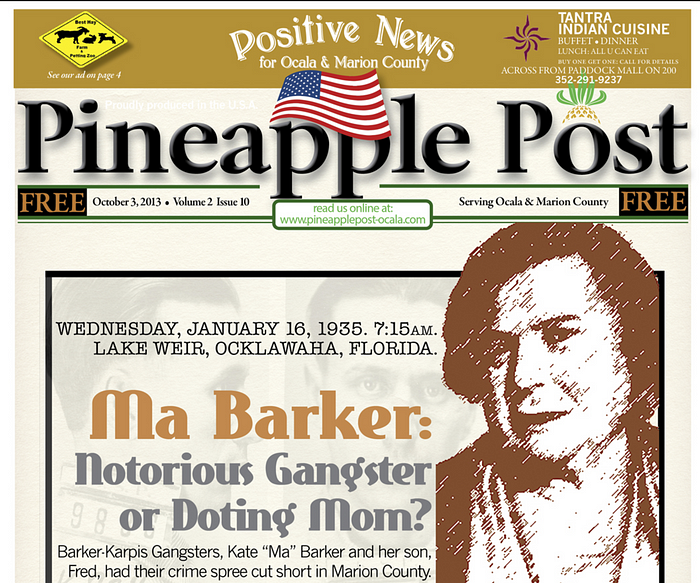Ma Barker: Notorious Gangster or Doting Mom?

The Barker-Karpis gang of the early 1930s was one of the most notorious collections of villains to plague America during the Age of Gangsters. They were a bunch of criminal misfits, drawn together by friendship, family, and a thirst for easy money. The Barker-Karpis Gang was led by either Alvin Karpis or “Ma” Barker (Arizona “Arrie” Donnie Clark aka Kate “Ma” Barker — pick your favorite name) — it depends on which version of the tale is to be believed. At the time of her death-by-federal-agents, at the age of 61 (or so), “Ma” Barker was considered a controlling, domineering matriarch of a ruthless gang of thugs who did her bidding. But, was she really? Or, was she a simple woman who just happened to go along with her murderous brood? A bank-robber friend of the family, Harvey Bailey, stated, “The old woman couldn’t plan breakfast. When we’d sit down to plan a bank job, she’d go in the other room and listen to Amos and Andy or hillbilly music on the radio.” Was she a notorious crime boss or just an inept housekeeper?
Our tale of woe begins in Missouri, on October 8, 1873 (possibly) — the day “Kate” was born. Kate went on to marry George Barker in 1892 and gave birth to four strapping boys — Herman, Arthur, Fred, and Lloyd. Around 1915, George skipped out on them. It was believed that George suffered from severe alcoholism and just couldn’t handle the responsibility of heading up a family of six. At this time, the Barker Boys began their new vocation in the art of crime. Kate didn’t really have a problem with this, as she enjoyed the luxuries that came with unearned wealth.
As the legend would have, Kate ruled her sinister troop with an iron fist as they murdered and plundered their way through the American Heartland. However, that legend may be no more than just a legend. True enough, Kate was involved and condoned the actions of her children, but she wasn’t necessarily the gun-toting, cigar-chomping zaftig as portrayed by Shelley Winters in Bloody Mama.
Creepy Karpis in the American Heartland
The purported head of the Barker-Karpis Gang was a fellow by the name of Alvin Karpis, who went by the nicknames “Creepy” and “Ray.” Creepy was born in Montréal, of Lithuanian descent, but raised in Topeka, Kansas. He was very industrious and began his career at the age of ten, bootlegging and causing all sorts of mayhem. It was at the Kansas State Prison that he met up with Fred Barker, and around 1931, a partnership was formed.
Unfortunately for the gang, they lost a few members early on. Arthur “Doc” Barker was sentenced to life in 1920 for killing a night watchman and Lloyd went to the big house in 1922 for mail theft and wasn’t released until 1938 — missing the big shootout in Ocklawaha. Lloyd went on to be an Army cook at a POW camp but was later murdered by his wife in 1949. She went to jail, too. Herman committed suicide in 1927 after being injured in a shootout in Wichita, Kansas. This left Fred and Doc, the only Barker spawn to accompany Creepy, Kate, and about 25 others on their big adventures.
The gang would go on to big escapades in the 1930s. They kidnapped the heir to the Hamm’s beer brewery fortune and abducted Edward Bremer, a prominent Minnesota banker. Both were released after the ransoms were paid.
Edward Bremer’s father was a friend of President Franklin Roosevelt, and by 1934, the Feds were stepping up their pursuit of gangsters, bringing down John Dillinger, Bonnie & Clyde, Baby Face Nelson, Pretty Boy Floyd and several others in that year alone.
J. Edgar Gets Tough on Ma Barker
J. Edgar Hoover was appointed acting head of the Bureau of Investigation in 1924. In the days before DNA or even fingerprinting, the Bureau had a tough time tracking down and capturing the bad guys. During a Senate hearing, Tennessee Senator Kenneth McKellar took J. Edgar to task for the Bureau’s poor performance and remarked that J. Edgar, himself, had never personally arrested anyone. J. Edgar would see that Senator McKellar would eat his words — he would arrest Alvin Karpis himself!
However, before J. Edgar’s big collar, there was the matter of the shootout in Ocklawaha. As it turns out, Kate and her groupies had high-tailed it to Marion County. Doc Barker was arrested in Chicago on January 8, 1935. In his possession was found a map that indicated the location of Kate & Freddie. They had rented a nice place from Carson Bradford for $75 a month on the shores of Lake Weir at 13250 Highway C-25, in Ocklawaha. Kate waved around a wad of cash and called herself “Kate Blackburn” and claimed Fred was her husband. Federal agents surrounded the house at about 7am on January 16, 1935, and opened fire. It took more than 2,000 rounds and four hours to bring down Fred and his mom. Whether Kate was a ruthless gangleader or just a lousy cook is uncertain, but she was found with a tommy gun (maybe) next to her bullet-riddled body. Also present at the scene was handyman Willie Woodberry and his wife. They were awakened early in the morning and tried take cover in a large stove. When that couldn’t be accomplished they snuck out through the side door of the service house. After the shootout, the FBI ordered Willie into the house to make sure the Barkers were dead.
The idea that Kate was a murderous thug may have been concocted by, none other, than J. Edgar himself. He needed justification for gunning down a 62-year-old woman. “The most ridiculous story in the annals of crime is that Ma Barker was the mastermind behind the Karpis-Barker gang. … She wasn’t a leader of criminals or even a criminal herself. There is not one police photograph of her or set of fingerprints taken while she was alive … she knew we were criminals but her participation in our careers was limited to one function: when we traveled together, we moved as a mother and her sons. What could look more innocent?” Creepy would later say. He vowed — via a personal letter to the Director — that he would kill J. Edgar in the fashion the Barkers were killed.
After Fred and Kate were killed, their bodies were put on display (bring the kids!), but went unclaimed until October 1935, when they were removed to Welch, Oklahoma to be buried next to George. J. Edgar got his man on May 1, 1936, in New Orleans. The story goes that agents had captured Karpis in his car and held him until J. Edgar could personally arrest him. When he ordered his agents to handcuff Creepy, they realized that no one bothered to bring any and Karpis was shackled with somebody’s necktie. He was the last “Public Enemy #1” to be brought down. Karpis was tried and sentenced to Alcatraz. He served his time there longer than anyone else. He was later transferred to McNeill Island Penitentiary, where he would make the acquaintance of a young Charles Manson. He was released in 1969, shipped off the Montréal, but later relocated to Spain, where, in 1973, he was found dead of an apparent overdose of sleeping pills. Or maybe he was murdered. Whatever.
Ma Barker: Bloody Mama
The legend of Ma Barker lives on to this day. In fact, if you are so inclined and have $889,900 burning a hole in your pocket, you could buy 9.5 acres and the house on Lake Weir. It even comes with bullet holes and the original furnishings, just like they were in 1935. It would help if you didn’t believe in ghosts.
Ma Barker and her exploits have been immortalized in film many times, with varying degrees of inaccuracy.
There was an episode of The Untouchables, in October 1959, with Kate played by Claire Trevor.
Ma Barker’s Killer Brood, a 1960 film starring Lurene Tuttle as Kate.
An episode of The Witness, in 1961, starred Joan Blondell as Kate.
Roger Corman’s Bloody Mama in 1970, with Shelley Winters as Kate. (In a 1966 episode of Batman, Shelley portrayed a slightly different version as “Ma Parker.” Holy crime boss, Batman!)
And in 1974, there was The FBI vs. Alvin Karpis, with Eileen Heckert as Kate.
Also a song, in 1977, by Boney M, titled Ma Baker. (No “r”). www.youtube.com/watch?v=yLzqMJQzzcA
In 1985–50 years since the shootout — Ocala held a “Ma Barker Day” commemorating the event. More than 5,000 attended with then Senator Karen Thurman as “Ma” and Representative Dick Locke as “Fred.” The event was a big success and filled a gap when the Citrus Festival was cancelled due to the Big Freeze of ’83.
This article appears in the October 2013 edition of The Pineapple Post-Ocala, Florida.
